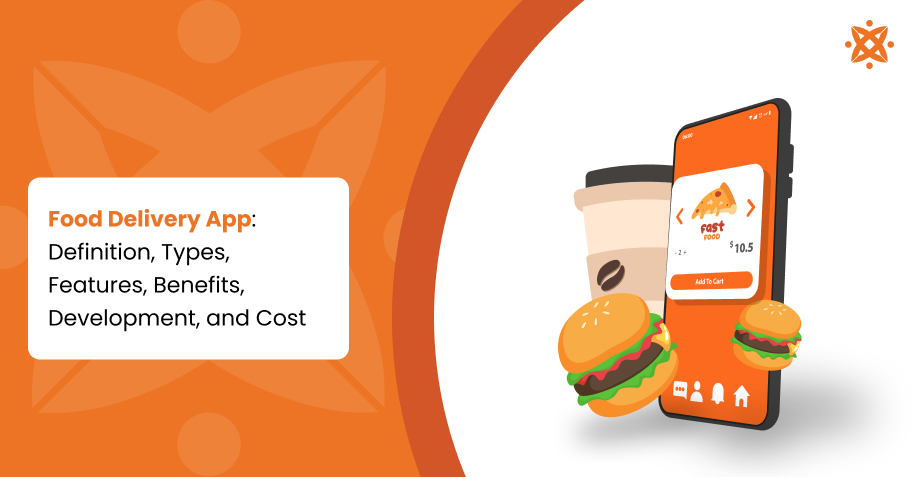
A food delivery app connects users to restaurants or food providers, enabling easy menu browsing, order placement, and payment integration via a mobile platform. These apps enhance convenience for both businesses and customers by offering real-time order tracking and delivery.
The different types of food delivery apps are aggregator apps, which connect customers with multiple restaurants; dedicated restaurant apps, which focus on single-brand customer reviews and services; and logistic support apps, which provide delivery solutions for restaurants.
Key features of the food delivery app include user registration, easy menu browsing, efficient order placement, and secure payment integration. Features such as real-time order tracking, push notifications, and customer reviews ensure a seamless experience for users and drive engagement.
The benefits of food delivery apps are customer base expansion, order placement, payment integration, real-time order tracking, and access to diverse options via menu browsing.
Developing a food delivery app involves conducting market research, defining essential functionalities like UI/UX and front-end and back-end coding, and ensuring compatibility across iOS, Android, or cross-platform systems. Rigorous testing guarantees reliability before deployment to the market.
According to a study by App Development Insights titled "The Economics of Food Delivery Apps," published in Tech Innovations Weekly (2022), the cost of developing a food delivery app ranges from $40,000 to $200,000. Costs vary based on complexity, cross-platform development, and advanced features such as real-time order tracking and push notifications.
- What Is A Food Delivery App?
- What Are The Different Types Of Food Delivery Apps?
- What Are The Key Features Of A Food Delivery App?
- What Are The Benefits Of Using Food Delivery Apps For Businesses And Consumers?
- How To Design And Develop A Food Delivery App Like Uber Eats And DoorDash?
- What Is The Cost Of Developing A Food Delivery App Like Uber Eats And DoorDash?
What Is A Food Delivery App?
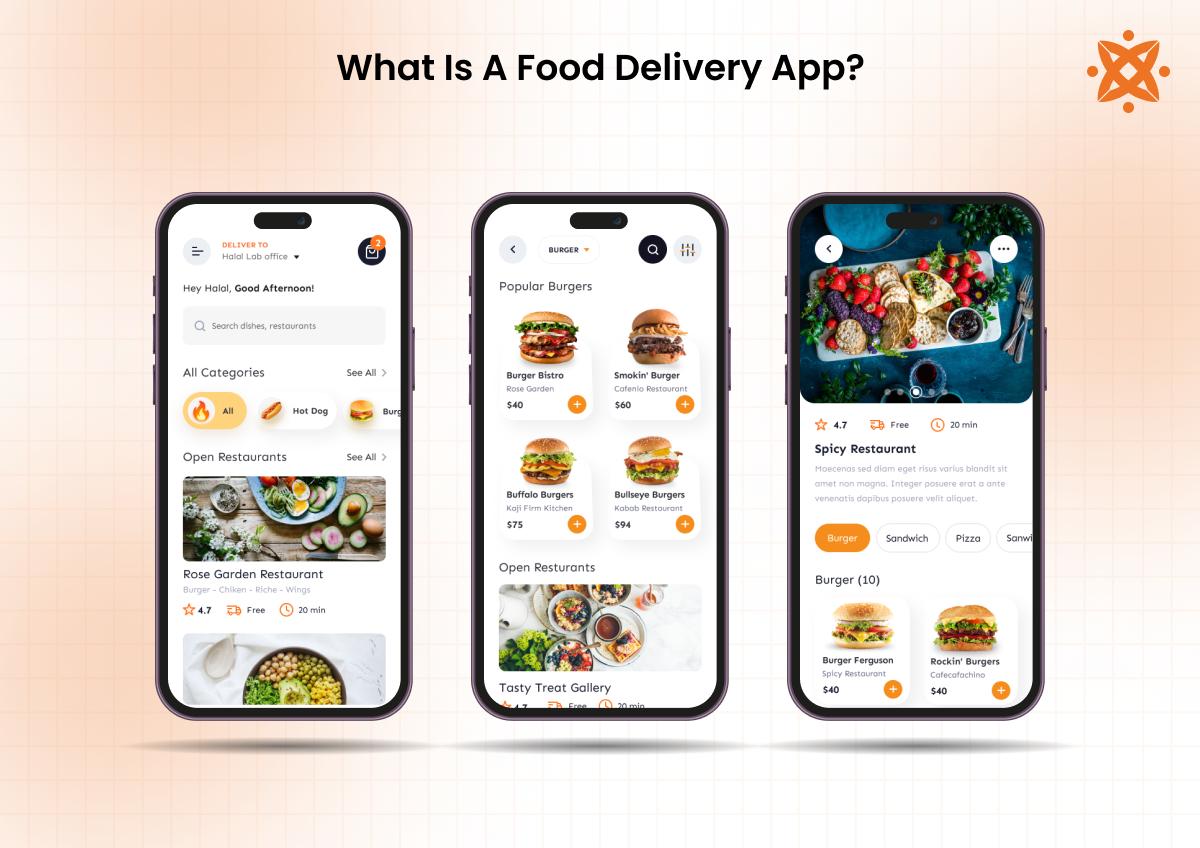
A food delivery app is a type of mobile app designed to facilitate the ordering and delivery of food from restaurants to customers. It provides features such as menu browsing, order placement, payment integration, and real-time order tracking, ensuring a smooth experience for users.
The interface includes user-friendly navigation for iOS, Android, or cross-platform systems, focusing on intuitive UI/UX.
Food delivery apps feature distinct sections for user registration, restaurant listings, and customer reviews to enhance functionality and trust.
The design uses visual elements like high-quality images, easy-to-read menus, and secure payment gateways, which make the app visually appealing and reliable for users.
According to a study by Statista titled "Food Delivery Apps: Usage Statistics and Market Share," published in Global App Trends (2023), over 45% of smartphone users globally utilize food delivery apps at least once a month. These statistics underline the growing reliance on food delivery apps in modern lifestyles.
What Are The Different Types Of Food Delivery Apps?
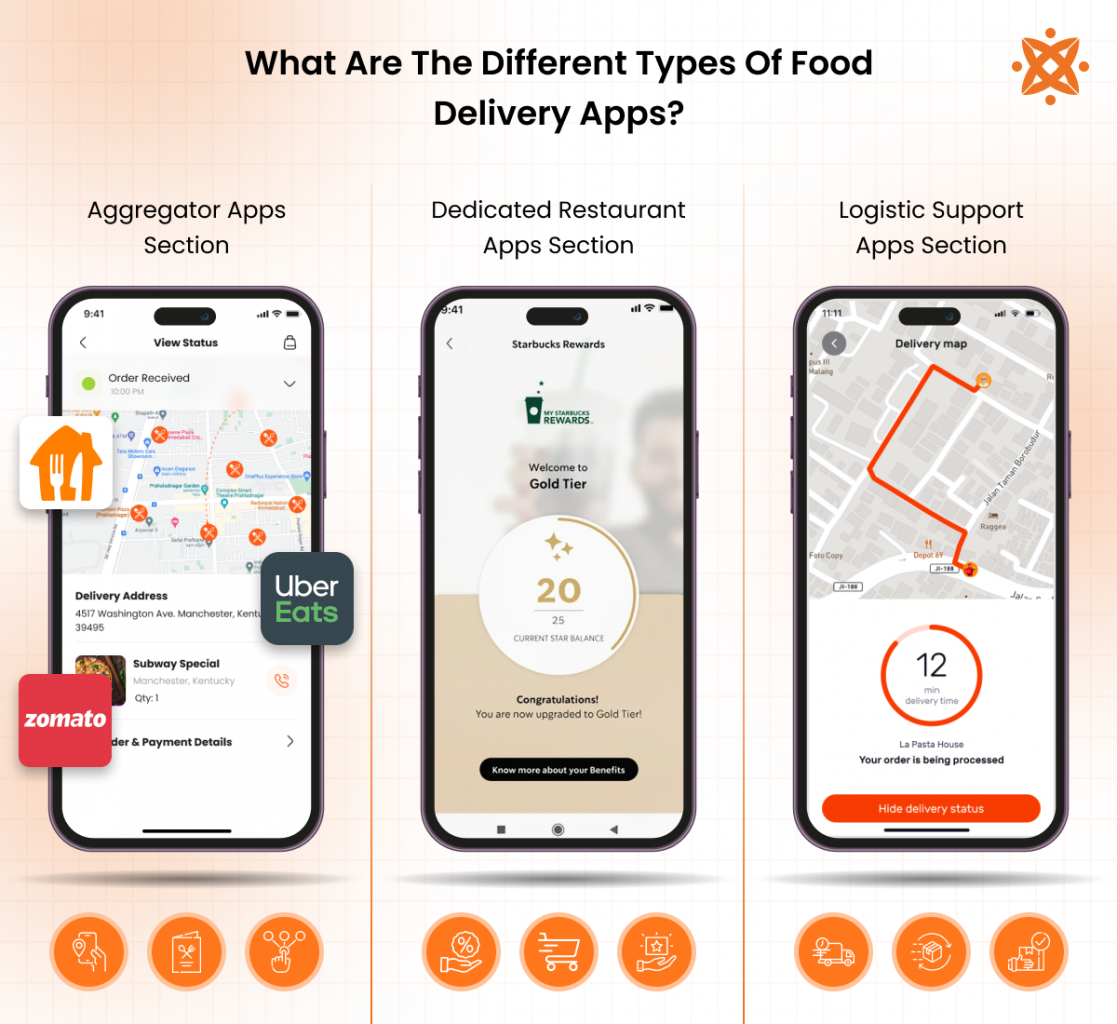
The different types of food delivery apps are aggregator apps, dedicated restaurant apps, and logistic support apps, each designed to cater to specific user and business needs.
According to Wikipedia, the global online food delivery market was valued at $90 billion in 2018 and is projected to reach $294 billion by 2021. This significant growth is attributed to increased smartphone usage, internet penetration, and consumer demand for convenience.
These categories vary in functionality, from connecting multiple restaurants to offering brand-specific or delivery-focused solutions, ensuring versatility in the mobile app market.
Aggregator Apps
Aggregator apps are platforms that connect multiple restaurants to customers, offering a centered hub for menu browsing and order placement. These apps allow users to explore various dining options while letting restaurants manage delivery logistics.
Examples of aggregator food delivery apps include:
- Uber Eats: A globally popular aggregator app that enables users to access menus from thousands of restaurants with intuitive UI/UX and real-time order tracking.
- Grubhub: Grubhub provides easy ordering and payment integration, making it a favorite among U.S. customers.
- Zomato: A widely-used app in Asia and the Middle East, combining food delivery with in-depth customer reviews for better decision-making.
Dedicated Restaurant Apps
Dedicated restaurant apps are custom-made for individual brands, allowing restaurants full control over their UI/UX, branding, and customer interactions. These apps streamline operations like order placement, payment integration, and push notifications.
Examples of dedicated restaurant apps include:
- McDonald’s App: Offers exclusive deals, real-time order tracking, and fast food delivery, especially for McDonald’s customers.
- Domino’s App: Integrates menu browsing, delivery tracking, and a loyalty program to enhance the pizza ordering experience.
- Starbucks App: Provides a personal form of experience with features like mobile payments and rewards, catering to coffee lovers.
Logistic Support Apps
Logistic support apps focus on assisting restaurants and food providers with delivery operations by managing the logistics process. These apps enable efficient real-time order tracking and communication between drivers and restaurants.
Examples of logistic support apps include:
- Postmates: Known for its flexible delivery services, offering support to restaurants lacking in-house delivery teams.
- DoorDash Drive: A logistics platform that integrates with restaurant systems to handle delivery needs.
- Deliverect: Helps restaurants optimize delivery processes by connecting their systems with various delivery apps.
What Are The Key Features Of A Food Delivery App?
The key features of a food delivery app include user registration, intuitive menu browsing, payment gateways, real-time order tracking powered by GPS technology, and push notifications for updates and promotions. They ensure convenience for users and operational efficiency for businesses.
The main key features of a food delivery app are:
- User Registration and Profile Management: These features allow users to create accounts, store preferences, and manage order histories. They ensure a personal form of experience and make repeat transactions efficient.
- Intuitive Menu Browsing: This functionality provides users with easy navigation through restaurant offerings, detailed menus, and visual representations of dishes. It makes the process of selecting and ordering food simple.
- Payment Gateways: Integrated systems that support secure and diverse payment methods. They enable fast and reliable transactions, enhancing user trust.
- Real-Time Order Tracking with GPS Technology: This feature allows users to track their order's progress from preparation to delivery. It improves transparency and increases satisfaction by keeping users informed.
- Push Notifications: Alerts sent to users about order status updates, promotions, and discounts. They improve user engagement and ensure timely communication.
What Are The Benefits Of Using Food Delivery Apps For Businesses And Consumers?
The benefits of food delivery apps are improved convenience for users and better operational efficiency for businesses. These apps simplify processes like order placement, payment integration, and real-time order tracking while also expanding customer reach and boosting engagement through push notifications.
Key Benefits for Consumers
- Convenience: Food delivery apps provide the ability to order meals from anywhere, eliminating the need to visit restaurants. Features like intuitive menu browsing and real-time order tracking save time and effort, making them ideal for busy lifestyles.
- Transparency and Reliability: With features like GPS technology for real-time order tracking, users can monitor their order status from preparation to delivery, ensuring confidence in the process.
- Payment Flexibility: Secure payment gateways support multiple payment methods, including cards, wallets, and digital transactions, offering consumers flexibility and safety.
- Access to Variety: By aggregating multiple restaurants in one platform, users have the ability to explore diverse cuisines, compare menus, and read customer reviews, all within a single app.
Advantages for Businesses
- Expanded Customer Reach: Apps like aggregator apps and dedicated restaurant apps enable businesses to connect with a broader audience beyond their local reach, increasing sales potential.
- Operational Efficiency: Automation of processes such as order placement and payment integration reduces human error, smoothens workflows, and allows businesses to focus on food quality and service.
- Customer Engagement: Features like push notifications help maintain direct communication with customers, promote discounts, new menu items, and special deals, and boost loyalty and sales.
- Data-Driven Insights: Apps provide valuable analytics on customer behavior, preferences, and order trends, helping businesses make informed decisions to improve offerings and services.
- Brand Identity: Restaurants using dedicated restaurant apps customize their app’s UI/UX, ensuring consistent branding and a unique user experience that strengthens their market presence.
Do Food Delivery Apps Contribute To Obesity?
Yes, food delivery apps contribute to obesity by encouraging frequent consumption of high-calorie, low-nutrient foods, which are less healthy than home-cooked meals.
A study titled "From click to calories: Navigating the impact of food delivery apps on obesity," published in Open Health (2024), highlights that the convenience of food delivery apps may inadvertently lead to an overreliance on high-calorie and less nutritious options, potentially exacerbating the obesity epidemic.
This frequent access to calorie-dense options increases daily caloric intake, leading to weight gain over time. The convenience provided by food delivery apps, such as real-time order tracking, intuitive menu browsing, and seamless payment gateways, also reduces the need for physical activity, as users can effortlessly access meals without leaving their homes.
These behaviors, combined with sedentary lifestyles, create a cycle that promotes weight gain. The lack of portion control in restaurant-prepared meals, larger than what would be consumed at home, further exacerbates the issue. Over time, these factors contribute to increased risks of obesity and related health conditions, such as diabetes and cardiovascular diseases.
How To Design And Develop A Food Delivery App Like Uber Eats And Door Dash?
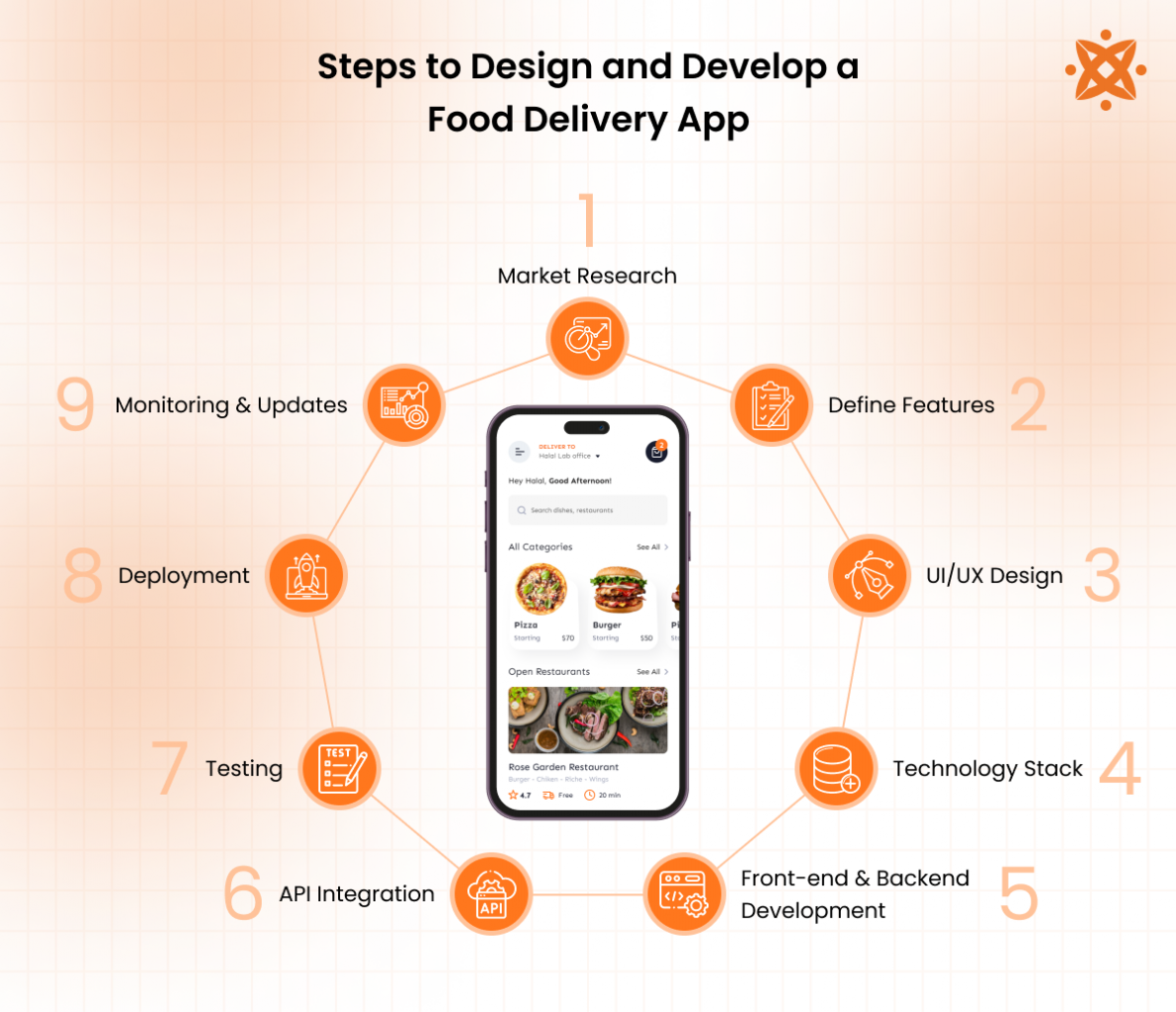
To design and develop a food delivery app like Uber Eats and DoorDash involves the following steps:
- Conduct market research to understand the target audience and market dynamics.
- Define the app's features and functionality requirements.
- Create a user-centric UI/UX design.
- Choose the appropriate technology stack, including cross-platform development frameworks.
- Develop the app's front-end development and backend development components.
- Implement API integration to connect services such as payment gateways and GPS tracking.
- Test the app extensively to ensure performance and reliability.
- Deploy the app for iOS, Android, or cross-platform platforms.
- Continuously monitor and update the app post-launch.
This process involves selecting the right backend tech, creating intuitive designs, and performing rigorous testing to deliver a high-quality product.
1. Conduct Market Research To Understand The Market Dynamics
Conducting market research is the foundational step in developing a food delivery app, ensuring the app aligns with user needs and market trends. This involves analyzing target audiences, understanding competitors, and identifying gaps in the current offerings.
Developers gather research information to define the app's unique value proposition and determine its key functionalities, such as API integration for third-party services or UI/UX design enhancements.
The process begins with identifying the target audience's demographics, preferences, and pain points. Surveys, focus groups, and interviews are useful tools for gathering direct insights. Competitive analysis follows, examining successful apps like Uber Eats to understand their technology stack, features, and pricing models.
Developers also study emerging trends in cross-platform development frameworks and backend tech to determine the most suitable architecture for the app.
Tools such as Google Trends, Statista, and industry-specific analytics platforms aid in gathering data, while SWOT analysis helps assess strengths, weaknesses, opportunities, and threats. This step lays the groundwork for the app's design and feature development, ensuring it meets market demands and user expectations.
2. Define The Essential Features And Functionalities Of The App
Defining the essential features and functionalities ensures that the food delivery app meets user expectations while providing a seamless experience. This step involves identifying the app's core requirements, such as UI/UX design, real-time order tracking, and payment gateways while aligning with market needs discovered during research.
The process begins by listing must-have features, including user registration, menu browsing, and push notifications to keep users engaged.
Developers must also consider advanced functionalities like GPS integration for tracking deliveries and robust backend development to support high traffic. For scalability, compatibility with iOS, Android, and cross-platform development frameworks must be included.
To define these functionalities, developers use tools like wireframing platforms (e.g., Figma or Adobe XD) to visualize the app’s flow. Collaboration software, such as Trello or Asana, helps organize feature development stages. Prioritize relevant elements and developers to deliver value while maintaining the app's usability and reliability.
3. Design An Intuitive User Interface (UI) And User Experience (UX)
Designing an intuitive UI/UX is necessary to ensure that the food delivery app is user-friendly and visually appealing. This step focuses on creating a smooth navigation flow, aesthetic design, and functionality that aligns with user preferences and industry standards.
The process begins with creating wireframes and prototypes to map out the app's interface, ensuring essential features like menu browsing, order placement, and real-time order tracking are easily accessible.
Color schemes, typography, and icons are selected to enhance the visual design, while usability testing ensures that users can intuitively navigate the app. Accessibility is also considered, ensuring the app functions optimally across iOS, Android, and cross-platform development frameworks.
Tools like Figma, Adobe XD, and Sketch are commonly used for prototyping and designing. Collaboration tools such as Slack or Jira help developers and designers communicate effectively during this phase. A well-designed UI/UX not only improves user satisfaction but also enhances retention and engagement.
4. Develop The App's Front-End And Back-End Components
Developing the front-end and back-end components ensures the food delivery app functions smoothly and provides a seamless user experience.
The front-end development focuses on user-facing elements, such as menu browsing, order placement, and real-time order tracking, while the backend development handles server-side processes like data storage, user authentication, and API integration.
The process starts with choosing a suitable technology stack. For the front end, frameworks like React Native or Flutter enable cross-platform development, ensuring compatibility with iOS and Android.
For the backend, technologies like Node.js or Django are paired with databases like MongoDB or PostgreSQL to handle high-performance requirements. Developers implement features like push notifications and secure payment gateways during this stage to enhance functionality.
Version control systems like Git ensure collaborative coding, while CI/CD tools like Jenkins streamline deployment. Regular debugging and code reviews are performed to ensure the app’s architecture is efficient and scalable. This stage sets the foundation for a reliable, user-friendly application.
5. Test The App Thoroughly To Ensure Quality And Reliability
Thorough testing ensures the food delivery app operates smoothly across platforms and meets user expectations for performance and reliability. This step involves evaluating the app's features, such as real-time order tracking, payment gateways, and push notifications, to identify and resolve any issues before deployment.
The process begins with functional testing to verify that features like user registration, menu browsing, and order placement work as intended. Performance testing follows, assessing the app's responsiveness under varying loads.
Compatibility testing ensures smooth operation across iOS, Android, and cross-platform development frameworks. Additionally, security testing identifies vulnerabilities in API integration and backend development to protect user data.
Tools like Selenium, Appium, and JIRA are commonly used for automated testing and bug tracking. Manual testing complements these tools by simulating real-world scenarios. By addressing errors during this phase, developers guarantee a polished and reliable app that is ready for deployment.
6. Deploy The App To The Market And Monitor Performance
Deploying the food delivery app to the market ensures users access and benefit from its features, while performance monitoring helps maintain functionality and optimize user satisfaction. This step focuses on publishing the app on platforms like iOS and Android, followed by tracking its performance to address issues post-launch.
The process begins with preparing the app for submission by adhering to platform guidelines for stores like the Apple App Store and Google Play Store. Deployment involves uploading the app, providing descriptions, and ensuring compatibility through cross-platform development frameworks.
Once live, monitoring tools like Google Analytics and Firebase track user behavior, while crash reporting tools identify and resolve technical problems.
Regular updates are planned to improve the app’s UI/UX, integrate user feedback, and enhance features such as real-time order tracking and push notifications. Continuous monitoring ensures that the app maintains high performance, reliability, and user satisfaction.
Where Can I Find A Food Delivery App Design Template?
Food delivery app design templates are found on platforms like Figma, Adobe XD, and Sketch, which offer pre-designed frameworks tailored for UI/UX in mobile apps.
These templates provide layouts and components optimized for features like menu browsing, real-time order tracking, and user registration, allowing developers to save time while maintaining high design standards.
According to a resource by Free Figma Templates titled "Food Delivery App UI Kits," published in Free Figma Templates (2023), the platform offers a variety of customizable templates designed specifically for food delivery apps, featuring key screens for user interfaces like homepages, product descriptions, and cart pages.
These templates include responsive designs compatible with iOS, Android, and cross-platform development frameworks, ensuring flexibility during implementation.
How Important Is A Logo For A Food Delivery App?
A logo is very important for a food delivery app as it represents the brand identity and creates a memorable impression among users.
A well-designed logo enhances the app’s recognition and credibility, especially in a competitive market where visual branding influences user trust and engagement.
According to research by Peters, T. (1999), titled "The Brand You," logos work to help companies or brands accelerate their recognition.
Logos also help reinforce the app’s core values and functionality, aligning with features like real-time order tracking, payment gateways, and seamless UI/UX. Investing in a unique logo ensures a strong market presence and boosts brand loyalty.
What Are The Best Food Delivery Apps For College Students?
The best food delivery apps for college students are those that offer affordability, convenience, and a wide variety of dining options.
Apps like Uber Eats, DoorDash, and Grubhub cater specifically to this demographic by providing discounts, flexible payment gateways, and reliable real-time order tracking.
According to a study by Zion & Zion titled "Food Delivery Apps: Usage and Demographics," published in Zion & Zion Research (2023), 63% of individuals aged 18 to 29, including college students, have used a multi-restaurant food delivery service in the past 90 days, showing a high level of engagement with food delivery platforms among younger consumers.
These apps feature intuitive menu browsing and push notifications for promotions, making them highly appealing to budget-conscious students looking for convenient meal options.
What Are The Best Food Delivery Apps For Drivers?
The best food delivery apps for drivers are those that offer competitive earnings, flexible schedules, and efficient tools for managing deliveries.
Apps like DoorDash, Uber Eats, and Grubhub are popular among drivers due to features such as real-time order tracking, intuitive UI/UX design, and prompt payments through integrated payment gateways.
These platforms also provide seamless cross-platform development frameworks for mobile usability, ensuring drivers efficiently navigate and complete orders. Such features make these apps reliable and driver-friendly.
What Tools And Technologies Are Used In Food Delivery App Like Uber Eats And Door Dash Development?
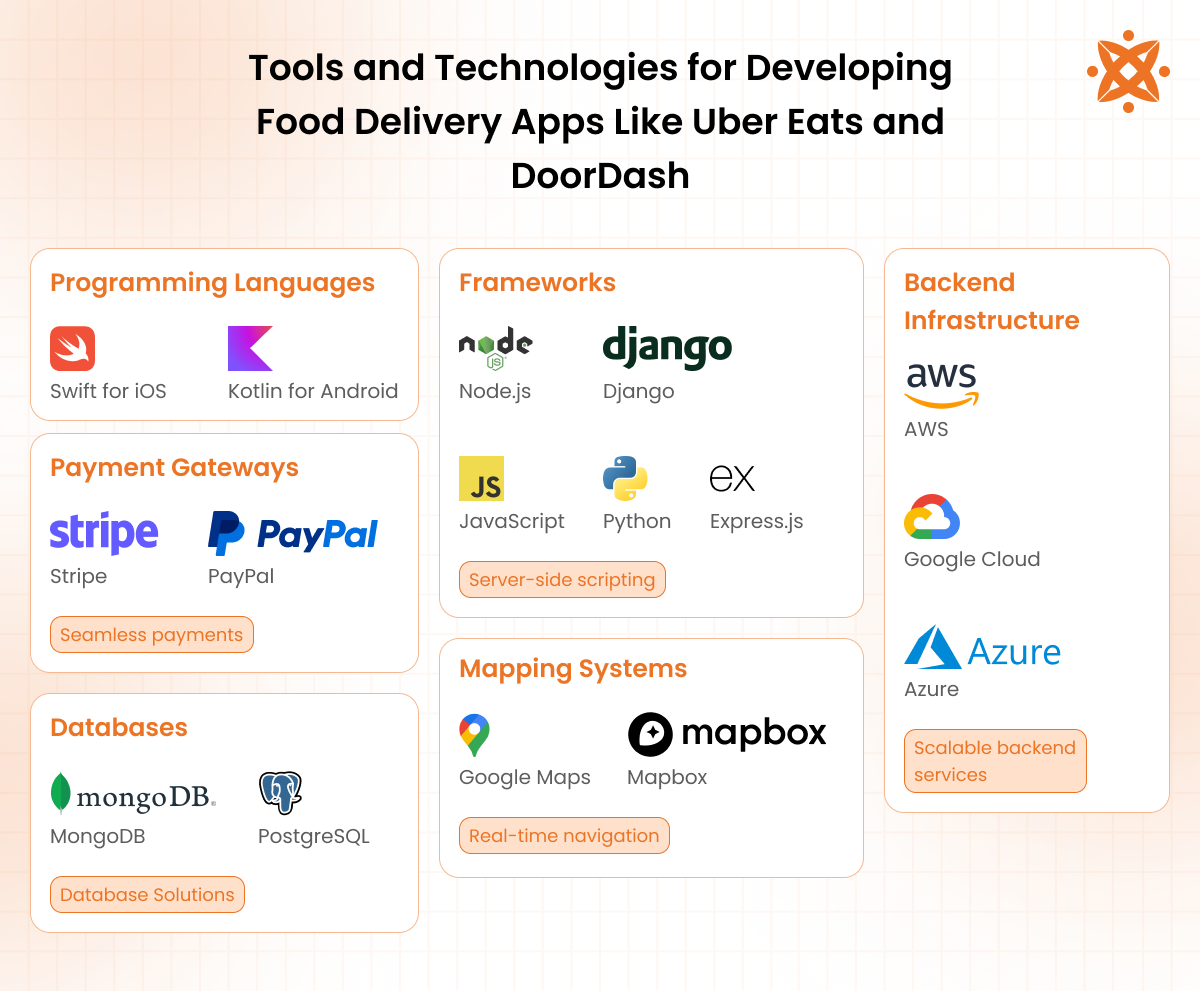
The tools and technology used in food delivery apps like Uber Eats and DoorDash development include tools for programming languages and frameworks, mapping technologies, and secure payment gateways. These technologies all work together to support real-time order tracking, UI/UX design, and reliable backend systems.
Programming Languages and Frameworks
Programming languages and frameworks form the backbone of front-end development, backend development, and cross-platform development frameworks, ensuring apps are functional and efficient.
Tools used in programming languages and frameworks include:
- Swift for iOS: A programming language used to build fast, efficient apps for Apple devices, offering native performance and rich features.
- Kotlin for Android: A preferred language for Android app development, known for its concise syntax and enhanced productivity.
- JavaScript or Python for backend development: JavaScript is widely used for interactive app components, while Python ensures efficient server-side operations.
- Node.js: A JavaScript runtime that supports scalable and fast server-side applications.
- Django: A Python-based framework that makes backend tasks like user authentication and database management simple.
- Express.js: A lightweight framework for Node.js, ideal for building flexible backend systems.
Mapping and Navigation Technologies
Mapping technologies ensure accurate real-time order tracking and optimized delivery routes. The tools used in mapping and navigation technologies include:
- Google Maps API: A tool for integrating geolocation, mapping, and navigation into apps with reliable accuracy.
- Mapbox: A customizable mapping platform used for unique location-based features and visualizations.
Payment Gateways and Security Tools
Payment gateways and security tools enable secure, fast, and reliable payment integration, ensuring user trust.
- Stripe: A versatile platform offering secure payment processing and easy integration.
- PayPal: A widely used payment gateway supporting online transactions.
- Braintree: Provides seamless payment solutions for credit cards and wallets.
- Encryption technologies: Ensure secure data transmission by protecting user information from cyber threats.
Backend Infrastructure and Database Solutions
Backend systems manage app functionality and data, ensuring scalability and efficiency.
- Cloud platforms (AWS, Google Cloud, or Microsoft Azure): Offer storage, computing power, and tools for scalable backend operations.
- Databases (MongoDB or PostgreSQL): MongoDB is ideal for handling large data volumes, while PostgreSQL ensures reliable relational database management.
These tools and technologies work together to deliver special features like real-time order tracking, efficient API integration, and cross-platform compatibility.
What Is The Cost Of Developing A Food Delivery App Like Uber Eats And Door Dash?
The average cost of developing a food delivery app like Uber Eats or DoorDash ranges from £15,000 to £45,000, depending on the app's complexity, features, and platform compatibility. Several cost factors influence the total expense, including development stages, technology stack, and design elements.
The features and functionality significantly impact the cost. Basic features like user registration, menu browsing, and payment gateways cost between $10,000 and $15,000.
Advanced functionalities such as real-time order tracking, push notifications, and GPS integration add $15,000 to $30,000, especially for apps designed with cross-platform development frameworks.
The technology stack and platform choice also contribute to the overall expense. Developing for iOS or Android individually costs $15,000 to $25,000 per platform, while cross-platform development using frameworks like Flutter or React Native ranges from $20,000 to $35,000. Backend infrastructure, including cloud platforms and databases, costs an additional $10,000 to $25,000.
Lastly, the UI/UX design and testing phase adds $8,000 to $15,000. This step ensures the app is visually appealing, user-friendly, and free of bugs, ultimately enhancing user experience and retention.
Maintenance and updates post-launch also require a recurring cost of $5,000 to $10,000 annually, ensuring the app remains reliable and competitive.
What Is The Difference Between A Food Delivery App And A Grocery Shopping App?
The primary difference between a food delivery app and a grocery shopping app lies in its core services: food delivery apps facilitate the ordering and delivery of prepared meals from restaurants. In contrast, grocery shopping apps enable users to purchase raw ingredients and household essentials for home preparation.
This difference influences their design and functionality, with food delivery apps emphasizing features like menu browsing, real-time order tracking, and payment gateways. In contrast, grocery apps focus on product catalogs, inventory management, and bulk purchasing options.
Grocery shopping apps are designed to provide detailed product information and efficient navigation to facilitate the selection of multiple items, catering to users seeking convenience in their grocery shopping experience.
What Are The Current Market Trends In Food Delivery Apps?
The current market trends in food delivery apps focus on personalization, the rise of cloud kitchens, and technological innovation. Food delivery platforms increasingly adopt features like real-time order tracking, GPS technology, and push notifications to enhance user experiences and engagement.
According to a study by Grand View Research titled "Online Food Delivery Market Report," published in 2023, the global food delivery market was valued at $221.65 billion in 2022 and is projected to grow at a compound annual growth rate (CAGR) of 10.3% from 2023 to 2030.
The report highlights that the expansion of cloud kitchens, which reduce operational costs for restaurants, and the integration of advanced technologies like AI have significantly driven market growth.
These trends show the industry's focus on convenience, cost-effectiveness, and adapting to evolving consumer demands.
How Do You Increase User Engagement In A Food Delivery App?
Increasing user engagement in a food delivery app involves implementing personal experiences, gamification elements, and leveraging geo-targeted promotions.
Personal user experience is achieved through AI-driven recommendations and marketing campaigns, which improve user satisfaction and conversion rates.
Gamification strategies, such as the use of interactive features and rewards, also make the ordering process more engaging and encourage repeat usage.
Geo-targeted promotions utilize location-based technology to offer timely and relevant deals, increasing the likelihood of user engagement.
How Do Food Delivery Apps Generate Revenue?
Food delivery apps generate revenue through various streams, including commission fees from restaurants, delivery charges to customers, in-app advertising, and subscription models.
Restaurants pay a commission fee for each order placed through the app, which ranges from 15% to 30%, depending on the platform. Customers contribute through delivery fees, which vary based on factors such as order size and distance.
In-app advertising serves as another revenue source, allowing restaurants to promote their services directly within the app.
Subscription models also provide users with perks like free deliveries or exclusive discounts for a monthly fee, creating a steady income stream.
These diverse approaches enable food delivery apps to sustain operations and profitability while catering to different user needs.
What Marketing Strategies Are Effective For Promoting Food Delivery Apps?
Effective marketing strategies for food delivery apps include promotions, influencer partnerships, and geo-targeted advertising. Personalized promotions, such as discounts and loyalty rewards, encourage user retention and repeat orders by catering to individual preferences.
Influencer partnerships help enhance brand visibility and credibility by showcasing the app's features to a broader audience.
Geo-targeted advertising allows apps to reach users in specific locations with relevant offers, increasing the chances of conversion.
Engaging in social media campaigns and leveraging push notifications for timely updates about deals or discounts further boosts user engagement.
These strategies work collectively to attract new users and retain existing ones, ensuring the app’s growth and profitability.
What Security Measures Are Essential For Food Delivery Apps?
Essential security measures for food delivery apps include data encryption, secure payment gateways, and robust user authentication systems.
Data encryption ensures that sensitive information, such as user credentials and payment details, is securely transmitted and stored.
Secure payment gateways protect financial transactions, reducing the risk of fraud and unauthorized access.
User authentication systems, such as multi-factor authentication (MFA), add a layer of security by verifying user identities before granting access.
Regular security audits and compliance with industry standards further strengthen the app’s defenses.
These measures not only protect user data but also enhance trust and reliability, which are relevant to the app’s success.
What Is The Best Food Delivery App In London?
The best food delivery app in London is Just Eat, known for its extensive restaurant network, user-friendly interface, and efficient delivery services.
Just Eat offers a wide range of dining options, from high-end restaurants to local favorites, catering to diverse tastes and preferences.
According to a report by Edison Trends titled "UK Food Delivery Market Share," published in Edison Trends (2021), Just Eat held the largest share of the UK food delivery market at 45%, making Just Eat the leading food delivery app in London.
The app integrates features like real-time order tracking, secure payment gateways, and push notifications, ensuring a seamless experience for users. Just Eat’s subscription service provides free deliveries for a monthly fee, further enhancing its appeal.
These features, combined with reliable customer support and a focus on convenience, make it a top choice for food delivery in London.
What Is The Cheapest Food Delivery App In The UK?
The cheapest food delivery app in the UK is Uber Eats, which frequently offers discounts, promotional deals, and low delivery fees compared to its competitors.
The app’s dynamic pricing model reduces delivery charges during off-peak hours, making it a cost-effective option for budget-conscious users.
According to a report by London Loves Business titled "Uber Eats Announces Growth: App Now Covers 90% of UK Population," published in London Loves Business (2024), Uber Eats covers 90% of the UK population, reflecting its extensive availability and accessibility.
Uber Eats also provides a subscription service, Uber One, which offers free deliveries and exclusive discounts for a fixed monthly fee, further lowering overall costs.
Integrating features like real-time order tracking, secure payment gateways, and promotions provides affordability without compromising on service quality.
How Do I Choose A Reliable Food Delivery App Development Firm Near Me In The UK?
Choosing a reliable food delivery app development firm in the UK involves evaluating their experience, portfolio, and technical expertise.
Look for firms with proven experience in developing cross-platform apps with features like real-time order tracking, secure payment gateways, and push notifications.
A strong portfolio showcasing similar projects demonstrates the firm's ability to deliver high-quality apps tailored to specific business needs. Consider their use of modern technologies, such as UI/UX design tools and robust backend development practices, to ensure your app is scalable and efficient.
Transparent communication, adherence to timelines, and positive client reviews further indicate an app development firm’s reliability and professionalism.
Never Miss an Update From Us!
Sign up now and get notified when we publish a new article!
Dhaval Sarvaiya
Co-Founder
Hey there. I am Dhaval Sarvaiya, one of the Founders of Intelivita. Intelivita is a mobile app development company that helps companies achieve the goal of Digital Transformation. I help Enterprises and Startups overcome their Digital Transformation and mobile app development challenges with the might of on-demand solutions powered by cutting-edge technology.
